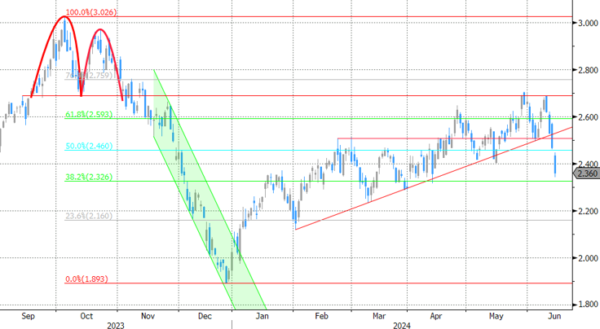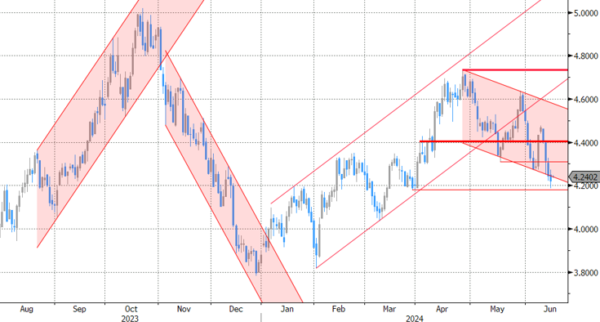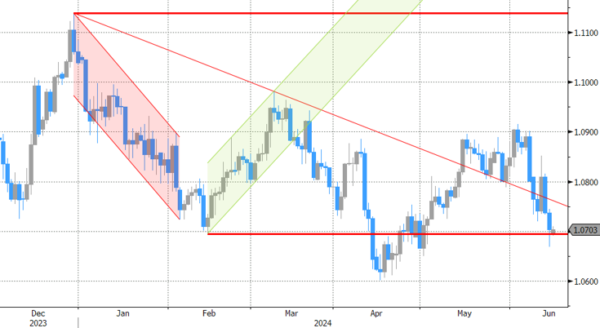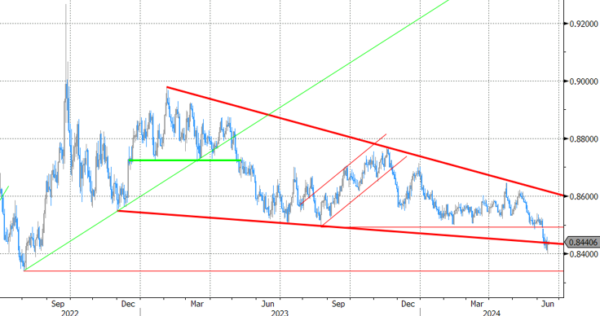Markets
The French/Macron-driven risk-off continued to rage across European markets last Friday. European risk premia again leaped aggressively higher. After a protracted period of underperformance against swap, German Bunds fully picked-up their traditional safe haven role. German yields declined between 10.7 bps (5-y) and 14.1 bps (30-y), a move that is difficult to link to ECB interest rate expectations. Intra-EMU spreads widened sharply not only for France (+7 bps against Bunds) but also with substantial collateral damage for the likes of Italy (+10 bps), Greece (+11 bps), Spain (+7 bps) or Portugal (8 bps). Even core and semi-core countries didn’t escape the repricing. European equities remained in free-fall (EuroStoxx 50 -1.95%, CAC 40 -2.66%). The euro didn’t escape the forces of gravity. EUR/USD intraday dropped below the 1.07 level, but managed to end the week near the big figure. The fall-out on US markets evidently was modest. US equities closed the session little changed, holding near (S&P 500) or even closing at record levels (Nasdaq). US yields moved between +0.8 bps (2-y) and -4.9 bps (30-y), testing (2-y, 4.70%) or tentatively breaking key downside resistance (10-y 4.25-30% area). Consumer confidence of the U. of Michigan also didn’t provide much comfort with sentiment sharply deteriorating (62.5 from 69.1 vs 72.0 expected) but inflation expectations at the same time holding stubbornly high (1-y 3.3%). Still the impact on markets was limited. Fed Kashkari and Fed Mester kept a balanced wait-and-see approach on Fed policy going forward even as price data last week mostly surprised to the downside (CPI, PPI but also may import prices published on Friday).
Asian markets continue to trade in risk-off modus this morning (Nikkei -1.90%). infra). US yields tentatively gain 2-3 bps. The dollar maintains last week’s gains (DXY 105.53, USD/JPY 157.50, EUR/USD 1.07). Today’s eco calendar is thin. Later this week, US retail sales (Tuesday) and the PMI’s (Friday) are interesting, but will be overshadowed by the developments in France and the broader risk context. Several central banks (National Bank of Hungary and RBA tomorrow, Swiss national Bank, Norges Bank and Bank of England on Thursday) decide on policy. Yields both in the US and Europe almost fully discount two rate cuts this year. In normal times this should help to build some bottoming, but especially in Europe, the risk-off might persist as first opinion polls on the French elections are filtering through. For EUR/USD, a further decline to the 1.06 support remains the path of least resistance.
News & Views
Rating agency Fitch affirmed Hungary’s BBB rating with a negative outlook. Strengths underpinning the rating are strong structural indicators relative to BBB peers, investment-fueled growth and solid net FDI inflows. Fitch balances these against high public debt compared, unorthodox policy moves and a worsening of governance indicators in recent years. The negative outlook reflects risks around the policy environment and the performance of public finances. It expects the budget deficit to narrow to 4.9%, above the 4.5% government target. The debt ratio could rise to 74.1% in 2024, before falling to 73.3% end-2025. GDP growth is expected to pick up to 2.3% this year on a recovery of private consumption and improving sentiment. Exports should boost growth to 3.8% next year and helps widening the current account surplus to 2% that year. Average annual inflation is seen at 4.4% in 2024 and 3.9% in 2025.
China’s monthly batch of economic data offered mixed signals. Industrial production rose 5.6% y/y in May, both easing from 6.7% the month before and missing estimates for a 6.2%. Retail sales surprised to the upside, coming in at 3.7% vs 3% expected and 2.3% in April. The jury is still out whether it’s the start of a bottoming out process after a drawn out period of consumer weakness. China’s National Bureau of Statistics also warned that domestic demand remains insufficient, adding that the external environment is complex and grim. The property markets shows little improvement, despite the government’s efforts. Property investments slumped 10.1% in the first five months YTD from a year earlier, deepening from -9.8% in January to April. Residential property sales tanked 30.5% YtD y/y. New home (-0.71%) and used home (-1%) prices declined further The yuan stabilizes near 8-month lows (USD/CNY 7.255).
Graphs
GE 10y yield
The ECB cut its key policy rates by 25 bps at the June policy meeting. A more bumpy inflation path in H2 2024, the EMU economy gradually regaining traction and the Fed’s higher for longer US strategy make follow-up moves difficult. Markets are coming to terms with that. For the time being, though, the political narrative dominates. After hitting a new YtD top at 2.7%, the German 10-yr yield corrected lower on safe haven bids.
US 10y yield
The Fed is seeking more evidence than just one slower-than-expected (May) CPI is providing. Upgraded inflation forecasts and a higher neutral rate complicate the exact timing of a first cut further. June dots suggest one move in 2024 followed by four more next year. Markets are positioned more aggressively, turning the recent low in yields into a technical support zone. The US 10-y yield is testing the downside of the 4.3/4.7% trading range.
EUR/USD
EUR/USD is trapped in the 1.06-1.09 range. The desynchronized rate cut cycle with the ECB exceptionally taking the lead, strong US May payrolls and a swing to the right in European elections pulled the pair away from 1.09 resistance. The Fed meeting balanced the weaker than expected US CPI outcome. Euro fragility makes a return to the 1.06 downside more likely than not.
EUR/GBP
Debate at the Bank of England is focused at the timing of rate cuts. Slower than expected April disinflation and a surprise general election on July 4 suggest that a June cut in line with the ECB looks improbable. Sterling gained momentum with money markets now discounting a Fed-like scenario. EUR/GBP tested the 2023 & 2024 lows near 0.85. Euro weakness eventually pulled the trick after French president Macron called snap elections following a weak showing in EU elections.

















